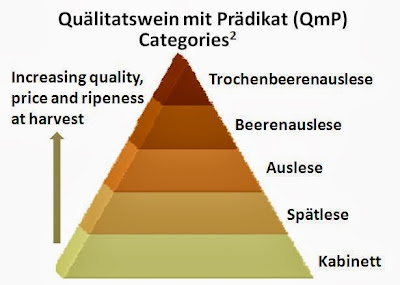According to the German Law which went into effect in 1971, German wines can fall into two main categories:
- Tafelwein or table wine
- Qualitätswein or quality wine of which there are two kinds: (1) Qualitätswein bestimmter Anbaugebite (QbA): QbA is a wine that comes from one of the 13 specified regions
(2) Qualitätswein mit Prädikat (QmP): QmP is a quality wine with distinction. It cannot be chaptalized. There are 5 levels of QmP wines and one way to visualize the increase in quality of the QmP wines is to depict it in a pyramid.
- Spätlese is a wine made from late harvested grapes
- Auslese is made from grapes that are selectively picked from ripe bunches
- Beerenauslese is made from individually selected grapes from ripe bunches
- Trochenbeerenauslese is made from trochen or dried grapes and is likely to taste raisinated
References:
1. Kevin Zraly, Windows on the World Complete Wine Course, 2009 Edition, Sterling Publishing, pg. 87-89.
2. UC Davis Online Course, Introduction to Winemaking, 092VID251.


No comments:
Post a Comment